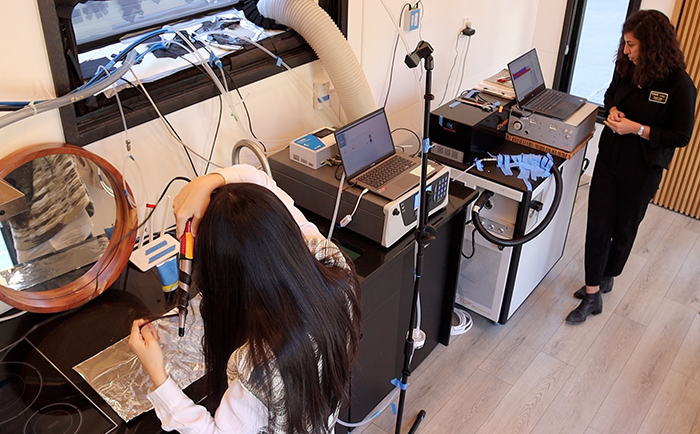Hazardous Hair Care

Research indicates common morning routine releases lingering toxic chemicals into the air
The average morning routine for many Americans includes inhaling several milligrams of chemicals that may be harmful to their health, Purdue University researchers have found.
A research team, led by Nusrat Jung, assistant professor of civil engineering, discovered that many chemicals linger in the air after use. On average, Jung’s team reports, a person can inhale a cumulative mass of 1-17 milligrams of potentially harmful chemicals in a single hair care session in their home.
“We found the results to be extremely alarming,” Jung said. “We did not expect to see such significant emissions of volatile chemical mixtures from off-theshelf hair care products during typical hair care routines that many people perform each and every day.”
One of the most frequent — and most concerning — chemicals inhaled, Jung said, is decamethylcyclopentasiloxane (aka D5 siloxane). It is an organosilicon compound often listed first or second in the ingredient lists of many hair care products, indicating it can be among the most abundant ingredients. It has become a common ingredient over the past few decades in many personal care products due to its low surface tension, inertness, high thermal stability and smooth texture.
“There has not been much in-depth research into this, so we really have no idea the extent of the threat these chemicals pose when inhaled over a long period of time,” Jung said. “There have been tests into wash-off products like shampoos, but almost none for leave-on products such as hair gels, oils, creams, waxes and sprays.”
According to the European Chemicals Agency, D5 siloxane is classified as “very persistent, very bioaccumulative.” And while the test results on laboratory animals is already concerning, Jung said, there is little information on its human impact.
Jung’s research also noted that applying high heat to these chemicals, through the use of curling irons and hair straighteners, serves to further release the chemicals into the air. When met with temperatures of 410 degrees Fahrenheit, researchers found the chemical emissions from hair care products increased anywhere from 50% to 310%.
To make matters worse, Jung said, these airborne chemicals do not merely remain in a single room — or even just the home.
“Home ventilation is likely a major pathway of indoor-to-outdoor siloxane transport,” Jung said. “In urban environments, this is especially significant as you will have hundreds — even thousands — of homes ventilating out potentially harmful chemicals into the urban atmosphere all in a short span of time as people get ready for work and school in the morning. These chemicals are then collectively piped back into buildings through ventilation systems. So even if using products with harmful chemicals is not part of your hair care routine, you will still be impacted due to your surroundings in an urban environment.”

Purdue civil engineering PhD student and researcher Jinglin Jiang conducts her hair care routine while Nusrat Jung, assistant professor of civil engineering, observes data inputs during hair care routine emissions experiments conducted in the Purdue zero Energy Design Guidance for Engineers (zEDGE) Tiny House.
Gathering the data
Jung’s experimental research was conducted in a residential architectural engineering laboratory: the Purdue zero Energy Design Guidance for Engineers (zEDGE) Tiny House.
“The work being done here has been just the start as we look toward the effects of other chemicals introduced into the air and environment,” said undergraduate researcher Grayson Wittbrod.
The hair care routine emission experiments were conducted during a measurement campaign in zEDGE over a period of several months. The process included three experiment types: realistic hair care experiments that replicate actual hair care routines in the home environment; hot plate emission experiments that explore the relationship between the temperature of the hair care tools and volatile organic compound emissions; and surface area emission experiments that investigate how hair surface area impacts volatile organic compound emissions during hair care events.
For the realistic hair care routine emission experiments, participants were asked to bring their own hair care products and hair styling tools to replicate their routines in zEDGE. Prior to each experiment, participants were instructed to separate their hair into four sections. The hair length of each participant was categorized as long hair (below the shoulder) or short hair (above the shoulder). The sequence of each experiment consisted of four periods, to replicate a real-life routine.
After hair styling, the participants had two minutes to collect the tools and leave zEDGE; this was followed by a 60-minute concentration decay period, in which zEDGE was unoccupied, and the high-resolution proton-transfer-reaction time-of-flight mass spectrometer monitored the decay in indoor volatile organic compound concentrations. The experiments and subsequent analysis focused on indoor volatile organic compound concentrations and emissions during and after active hair care routine periods.
This research was funded and supported by Purdue University, the Alfred P. Sloan Foundation and the National Science Foundation. Jung’s team plans to investigate the many other chemicals detected in these experiments that were not reported in this study.
